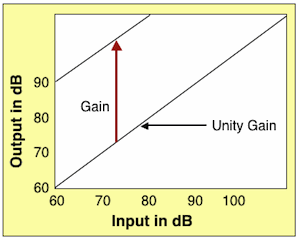Note: A hearing professional who regularly reads our blogs recently wrote: “I hear others talking about ‘unity gain’ when describing hearing aid amplification. What is unity gain and how is it implemented in hearing aids?” In order to answer this question, it is first necessary to review amplification, in general.
Hearing Aid Amplification
“Unity acoustic gain,” or simply “unity gain,” is best defined by understanding the basic concept of amplification. In hearing aids, amplification is best measured by the gain of an aid. Gain is the ability to take the low level of a signal and raise it to a higher level. Gain is simply the output level minus the input level. Thus, a 60-dB sound signal, which is amplified to an output of 90 dB, has a 30-dB gain (Figure 1). Where input equals output (lower curve of Figure 1), the aid is said to have a unity gain (i.e., a 1:1 ratio of input to output, or a gain of one, unity, or unity slope). When described in terms of the actual amplification provided, the gain is 0 dB. Zero dB describes the condition in which the hearing aid neither amplifies nor attenuates the incoming sound.

Figure 1. Input/Output curve, showing that gain is the deviation in output from the unity gain curve. In this example, the unity gain is 0 dB (60 dB in equals 60 dB out, or 1 gain), and amplification is 30 dB (output minus input).
In simple terms, gain can be best represented by an Input/Output curve as the deviation in output from the unity gain curve.
For practical use, a hearing aid must provide enough gain (amplification) for quiet sounds to be made audible to an individual with a hearing loss. So, an overall 0 dB unity gain is impractical because amplification is required to compensate for the loss of sensitivity of low-level sounds (as measured in threshold audiometry). And, because hearing loss is frequency dependent, the amount of amplification is not the same for all frequencies.
How is Unity Gain Used in Hearing Aids if There is No Amplification?
Hearing impaired individuals require different gain depending upon their hearing levels, their perception of subjective loudness, and on the level of the incoming sound signal, among other considerations. Generally, quiet input signals require greatest gain because they are not heard. However, as the incoming signal becomes louder, less gain is required, and in some cases, at some point, no gain, or unity gain, is appropriate. WDRC (Wide Dynamic Range Compression) hearing aids are designed to attempt to meet this range of amplification requirements and are common in hearing aids. To consumers, these hearing aids are advertised, as “making soft sounds louder and loud sounds soft.”
This concept was explained nicely by Dr. Marshall Chasin in a previous post on HearingHealthMatters.org and diagrammed in Figure 2.

Figure 2. Relative relationship between the sound input level and the amount of gain required for a hearing loss. This shows essentially an inverse relationship, which is the general goal of using a WDRC circuit hearing aid.
This shows an inverse relationship between the input sound level and the amount of gain required. It shows the hearing aid circuit to have maximum gain (24 dB) for soft input sounds (50 dB soft speech), and essentially no gain (1 dB – approaching unity gain) for the input signal with the greatest level (95 dB loud music). These are relative numbers based on an estimated 50-dB pure-tone average hearing loss, but clearly show the inverse relationship between the input signal level and the recommended hearing aid gain (amplification). In this case, unity gain at high levels is often the goal, especially for loud music and for most hearing losses that are moderate or less in degree.
Linear Versus Nonlinear Input/Output Curves

Figure 3. A suggested non-linear hearing aid input/output characteristic (red line) for a listener having a 45-dB hearing loss and complete loudness recruitment above 80 dB HL. The blue line is a linear 1:1 (unity gain) reference curve.
Figure 3 compares the Input/Output differences of linear (blue line) versus nonlinear amplification (red line), the latter identified as WDRC circuitry. A linear amplifier provides a consistent amount of gain across a wide range of input levels. That is, the increase in amplified output of the hearing aid has a 1:1 relationship to the input signal until the amplifier reaches the point of saturation.
Nonlinear amplification provides maximum, constant gain at low input levels (Figure 3). Through a mid-range of input sound levels, compression is engaged (2:1 in this case) until a high-level unity gain designation is set. Once unity gain has been reached, there may be no further reason to employ output limiting in the hearing aid circuit because there is 0 dB amplification gain.
Wayne Staab, PhD, is an internationally recognized authority in hearing aids. As President of Dr. Wayne J. Staab and Associates, he is engaged in consulting, research, development, manufacturing, education, and marketing projects related to hearing. His professional career has included University teaching, hearing clinic work, hearing aid company management and sales, and extensive work with engineering in developing and bringing new technology and products to the discipline of hearing. This varied background allows him to couple manufacturing and business with the science of acoustics to bring innovative developments and insights to our discipline. Dr. Staab has authored numerous books, chapters, and articles related to hearing aids and their fitting, and is an internationally-requested presenter. He is a past President and past Executive Director of the American Auditory Society and a retired Fellow of the International Collegium of Rehabilitative Audiology.







